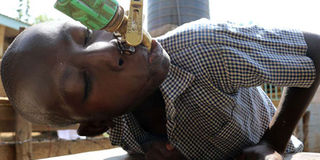Do more to ensure access to clean, safe water

A Kosawo Primary School pupil strains to get water in school on October 28, 2016. The United Nations classifies Kenya as a water-scarce country with a low natural water replenishment rate. PHOTO | FILE | NATION MEDIA GROUP
What you need to know:
- Water is life and everyone has the right to access sufficient, safe, physically accessible and affordable water for personal and domestic use.
- More can be done at the county level as regards e-waste management, garbage collection, tree planting, prevention of illegal logging and education of citizens.
Many urban dwellers have to buy water from vendors while the communities in arid and semi-arid areas trek long distances in search of the basic need.
The United Nations classifies Kenya as a water-scarce country with a low natural water replenishment rate.
Of the 46 million Kenyans, 41 per cent rely on unimproved water sources, such as ponds, shallow wells and rivers, and 59 per cent use unimproved sanitation solutions.
According to Water.org, only nine out of 55 public water service providers in Kenya have continuous supply.
According to a 2017 World Health Organisation report, 80 per cent of the people who have to use unsafe and unprotected water sources live in rural areas with around 159 million people collecting their drinking water from surface water such as ponds and streams.
Data from Unicef indicates that more than 700 children under five years die every day from diarrhoea linked to unsafe water and poor sanitation.
DEVELOPMENT
One in four primary schools has no drinking water with pupils using unprotected sources or going thirsty.
Water is life and everyone has the right to access sufficient, safe, physically accessible and affordable water for personal and domestic use.
In spite of this, many people are still left out due to population growth, adverse economic change, environmental degradation and displacement.
The access is even impeded when it comes to marginalised groups such as children, women and, more so, people living with disability.
Goal Six of the Sustainable Development Goals (SDGs) describes water and sanitation as being at the very core of sustainable development, critical to the survival of people and the planet.
Last year, the government reiterated its commitment to increase water access to 80 per cent by 2022 and attaining universal access by 2030.
The 100-day Rapid Results Initiative programme that it rolled out last year was a great start to speeding up implementation of projects and the monitoring and evaluation of results.
POLICIES
The country has also made great strides in legal framework through the development and amendment of the Water Bill, establishment of the National Steering Committee (NSC), development of the sixth draft National Water Policy and rollout of the National Water Policy.
But more needs to be done to promote access to clean and safe water, and that is a function of both the national and county governments.
The inter-governmental framework on water issues is critical if we are to improve water access and will require heavy investment and commitment by both levels of government.
More can be done at the county level as regards e-waste management, garbage collection, tree planting, prevention of illegal logging and education of citizens.
We heavily depend on water resources not only as drinking water, but also for crops, agriculture and livestock and fishing.
This calls for concerted efforts to address issues such as climate and environmental degradation, which are key to promoting access to safe water.
Ms Mathaga is the manager, Family Group Foundation. [email protected]





